Back in 1937 when the Beetle was still in the testing stage, a Dutch Opel dealer called Ben Pon wrote a letter to the GeZuVor in Germany. He was very interested in the Beetle and he wanted to know if it would be possible to import the car into Holland. In 1938 Pon got a letter from Porsche, telling him that he would become the official importer for Holland. Not much later the war broke out and the Beetle production for the public market was stopped.
After the war was over in 1945 the English regime in Germany started the production of the Beetle. Pon was still interested in the car and in 1946 he went to Germany. He bought 10 cars for the Dutch army and he also bought a second hand Beetle that he used as a show model. As a result of this trip he became the first importer of Volkswagen ever on August 8 1947. At this time he ordered 200 cars, but the production was not yet up to speed. The first 6 Beetles where picked up on October 16, 1947.At the end of 1947 there where 67 beetles in Holland. The next year the production started to get up speed and Pon and his dealers sold 1820 cars that year.
One of the first things Pon did was to establish a large dealer network and standardize the prices of repairs. You could get a booklet with most of the common repairs and their cost. An engine rebuild cost FL 7,50 ($ 5,00)!!! back then.
Not many people know that between 1954 and 1975 most Dutch bugs were assembled by D'leteren in Brussels, Belgium
Pon did not have to advertise a lot, as cars were a rare commodity after the war. The were so rare that you needed a coupon from the government to buy a car and even if you could get a coupon, you still had the problem of a small supply of cars. Volkswagen was one of the few manufacturers at that time, so a lot of people bought a car that was made by there former enemy despite there hostile feelings against Germany.
Soon, satisfied customers told their friends about their great German car.
Pon did not have to advertise much, but he always had a big stand at the annual cars-show in Amsterdam, at the RAI, and he used to give cars away to charity, which meant publicity. Besides these small publicity stunts, VW Holland published a monthly magazine for VW owners called "De VW, maandblad voor hen die Vooruit Willen" ("The VW, monthly magazine for those who want to move on"). This was published between 1954 and 1975.
In January, 1956, the 50,000th bug was imported into Holland.In February, 1959, the 100,000th VW was sold in Holland and the next 2 were given to charity after they had been driven around on a tram in Amsterdam.October, 1962 saw the 200,000th VW in Holland, February 7, 1968 the 300,000th bug and on November 14, 1973 the 750,000th VW was sold in Holland. After that, the Golf became very popular and was the next VW to make the books. In 1969 the bug fell from first place on the sales list. At this point VW started a big advertising campaign. The ads were based on the American ones, but they were never as good as the originals.
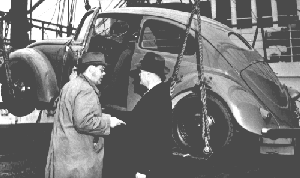
Besides being the first VW importer ever, Pon was also the first person to import a bug into the USA. The bug did not sell at first, but after a few years the demand was so big that customers in the states had to wait months to get their car. At this time some Dutch dealers started to upgrade Dutch bugs in order to sell them on the gray market in the USA. The gray market cars got towel rack bumpers, sealed beam headlights and a layered windscreen. Ben Pon did not approve of this method, but you could make a lot of money this way and a few dealers could not resist.
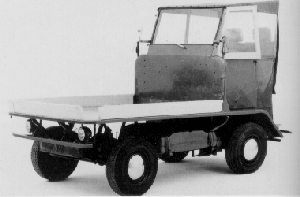
Probably the best thing Pon did for VW was the invention of the bus !When he was at the factory in 1947 he saw a bug chassis with a big loading floor and a cabin above the engine. It was used to move parts inside the factory. The workers called it the Plattenwagen.
When Pon was back in Holland he talked about importing it to Holland, but the position of the driver was unacceptable for the department of transportation. Pon started to think about a van based on the bugs chassis but with the driver up front. He made a drawing of his idea and at his next visit to the factory on April 23, 1947 (almost 50 years ago, there's gona be a party) he showed it to the manager of VWaG, who saw it's potential and in the fall of 1948 the first prototypes where built. The first prototypes used the normal bugs pan, but it had to be reinforced to take the extra load. Production started in February, 1950.
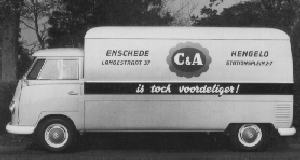
The busses became very popular in Holland, but some companies wanted to carry more load in one van. Biscut manufacturer Bolletje ordered some extra long busses from a small coachbuilder. When he went broke, Bolletje took their order to coachbuilder Kemperink. The conversion was based on a pickup that was stretched 3 feet. Customers could order a pickup or a high top version.
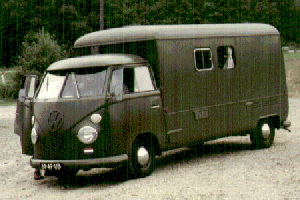
Besides Bolletje the cloting-company C&A and the dutch army used a lot of these converted busses. The army used them as mobile kitchens, supplyrooms and radiorooms. These vans are not so common but they show up at shows from time to time altough they usually are converted into campers.
The army and police also used lots of bugs over the years as patrol cars. Most drafted boys learned to drive in a bug. The airforce had special ambulances built by Visser. They were based on the factory option highroof, so they could store a second stretcher above the normal one. The normal factory approved ambulance was never so popular in Holland. Only a few cities and the autoclub used them.
Another big VW customer was the PTT or the Dutch post office. They used some bugs and a lot of busses to deliver mail. The bugs were specially addapted to carry lots of mail. All the seats (except for the driverseat ofcourse) were taken out and replaced with a wooden loading floor. This conversion wasn't so practical. The bus however was such a big succes that the PTT even uses them today (the vanagon version)
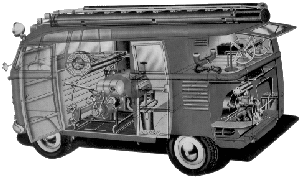
Kronenburg built another popular Dutch conversion. They made VW powered water pumps for the fire brigade and also modified VW vans into fire trucks. Of course, these busses were equipped with the Kronenburg pump. About 40 were built. Most of them were used as company fire trucks, so they were not much used and were well tken care for. Because they were in such good condition they were converted to campers by their second owners and as a result there are almost no originals left.
Some forces also had busses as command vehicles or bugs that the chief used as a mobile office.
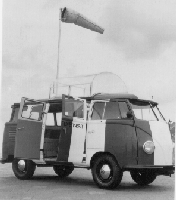
One of the most strange conversion was used on Schiphol airport. They used VW busses for about everything, but the conversion to a mobile air-control-tower was very strange. The roof was a see-through-plastic dome (l-w-h 3ft - 3ft- 2ft) and had a pole with a windbag !
The groundcrews and customs also used a lot of VW busses to transport people and good back and forth from the planes. They show up at meetings from time to time. You can easily spot them as they have lights on the rear corners of the roof. They were installed so taxiing pilots could spot them better.






